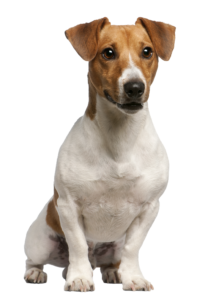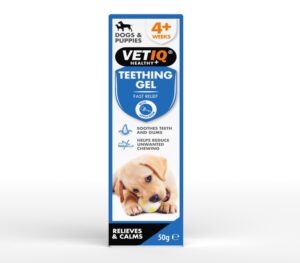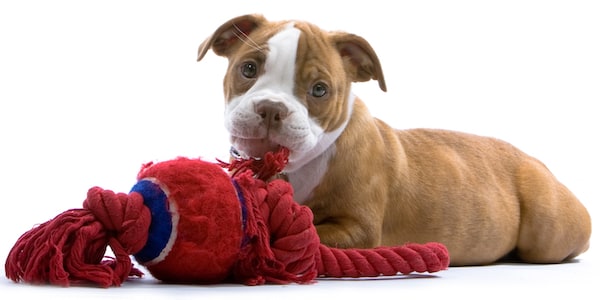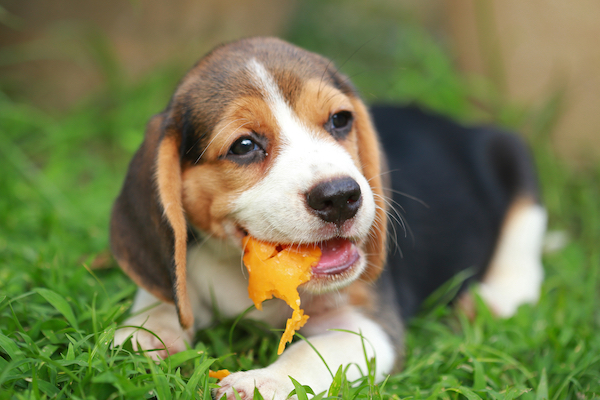When taking care of a growing puppy, teething can be one of the most sensitive and challenging times for both the owners and the puppy. Their newly arriving teeth are not only painful to them but can also be painful to much of your furniture, clothing and other household items as well as the pain in their gums drives them to gnaw on everything they can get their paws on to try and get some relief. But fear not; we’re here to help with some expert puppy teething tips!
The stages of puppy teething
The teething process for puppies lasts from one to three months. For first-timers, you need to know the timeline of your puppy’s teeth growth so you know what snacks, toys, and activities are best suited for them and when.
For starters, puppies are born toothless, just like humans. They then develop about 28 temporary teeth, called their puppy teeth, milk teeth, or deciduous teeth which are then replaced by 42 adult teeth.
2-4 weeks
Usually, at about two weeks, their first puppy teeth start to emerge from their gums.
Although it differs from puppy to puppy, the incisors are usually the first ones to appear, with six at the top and six at the bottom. These are usually followed by their long canines, with a pair on the top and a pair on the bottom, followed by their premolars.
5-6 weeks
During this period, the puppies generally have all of their 28 puppy teeth out and they are starting to eat soft foods. This differs slightly from breed to breed, but cold fruits or vegetables, and puppy-specific dog food are usually best at this stage.
The cool feeling they get with every bite helps soothe their hurting gums. Don’t give any ice cubes to your puppies at this stage though as their teeth are still weak and might misalign if they are given something too hard for them to chew.
12-24 weeks
Generally, their puppy teeth start getting pushed out and replaced by their permanent ones between 12 and 16 weeks old. They usually fall out in the same order they first appeared, incisors first, followed by their canine teeth at around 16 weeks and their premolars at around 24 weeks.
During this time, and with utmost care, it is a good idea to get your puppy used to touching the outside and inside of their mouth and their gums to help make them more comfortable with brushing their teeth in the future.
Six months and older
By this time, all of your puppy’s temporary teeth should have been replaced. Your puppy should have a total of 42 teeth – 12 incisors, 4 canines, 16 premolars, and ten molars.
If you still notice any puppy teeth sticking out, it’s a good idea to visit your veterinarian for a checkup, and they can advise on whether they need to be taken out.
Puppy teething pain
When babies are teething, they tend to be more irritable and cry louder, and for longer periods. The pain in their gums is quite similar to the teething pain experienced by puppies.
However, instead of crying, they tend to opt to bite, gnaw, and chew on hands, feet, shoes, furniture and pretty much any object they see, to try and alleviate the pain
Puppy teething is a natural process and is just one of the things they all have to go through.
Noticeable bloodstains on their toys or any bitten or gnawed items are symptoms of a teething puppy so there is no need to fret if you see these stains, as long as they are not overly big ones. If they are, consult your veterinarian immediately to check for any serious issues.
VetIQ Teething Gel
Soothing relief for teething puppies
- Helps soothe sore gums
- Helps reduce unwanted and destructive chewing
- With chamomile, peppermint & clove oils
- For puppies from 4 weeks
Puppy teething tips
While teething is painful and uncomfortable, there are things you can do to help alleviate the pain and help your puppy through the process.
1. Have plenty of soft, flexible toys available
Providing them with soft and flexible toys will benefit your puppy a lot. Just make sure that you always have these toys within reach, so they’re not chewing and destroying other things around your house, like your slippers, shoes, bags and furniture.
Try to avoid these toys during the teething stage:
- Easily broken toys
Avoid toys that might break after just a few chews. Make sure to invest in toys that will last, especially during this stage, as your puppies will chew the same thing or different things over and over again. - Toys that are too hard
Your puppy’s gums are sore. Biting on a too-hard object might just add to their pain and can cause the teeth to be damaged or to grow in incorrectly. - Toys that are too small
Very small toys might present as choking hazards. Since your puppies will bite and chew on their toys a lot while teething, make sure that the toy is an appropriate size and can’t be easily swallowed.
Try wetting a clean, wet cloth, twisting it into a cylindrical shape and popping it into the fridge or the freezer. It can make a great chew toy for teething puppies and the cold will help to ease their discomfort.
2. Puppy-proof your home
While your puppies are teething, make sure that you also keep their surroundings safe so both your puppy and your house make it through unscathed. Here are some things you can do to puppy-proof your home:
Keep their toys within their reach
Puppies will gnaw on anything they can reach; if they don’t have any of their toys near them, they will have no choice but to bite or gnaw on furniture, shoes, and any other household item that they can reach.
Keep your personal belongings out of reach
Puppies have a great sense of smell. Things you touch, own, or anything that smells like you will most likely get their attention. Personal items like keys, clothes, socks, shoes, or bags should be kept away from your puppies to avoid being broken.
Set up doggy gates
Doggy gates aren’t that high and are just enough for your puppies not to go to dangerous areas. These gates should be perfect for setting up safe boundaries for your puppies and avoiding any accidents, and keep them away from furniture and areas of the house that they might damage while seeking relief from teething pain.
Organise wires and cables
Wires and cables aren’t safe for teething puppies. Most power cables are left on the floor and can be easily accessed. Organising them and putting them out of your puppy’s sight and reach will be good for both your puppy’s health and for your gadgets.
3. Give them sensible treats
The sensation of chewing on cool or cold items can help to ease your puppy’s teething pain.
For example, cold carrots from the fridge can help to relieve their discomfort as well as provide them with some good nutritious benefits. However, don’t give your puppy more than one carrot per day, due to its high fibre content.
Frozen berries, strawberries and banana slices can also help, just let them thaw a bit first so they’re not too hard and prepare yourself for the mess your puppy might make with them!
4. Don’t scold or punish your teething puppy
It can be hard not to give out when you find your new shoe in tatters or the remote control chewed beyond recognition. But your puppy is experiencing a lot of pain and they are simply looking for relief.
Dogs respond well to positive reinforcement training, praising and rewarding them for “good” behaviour, and ignoring “bad” behaviour. Learned behaviour at the early stages of puppy life can carry on as your puppy grows.
So try to preempt and prepare for potential negative behaviour i.e. by puppy-proofing your home, and praise them and reward them for seeking relief with the toys and cold foods that you make available to them.
Puppy teething; a hard-won fight
The teething process can be a challenging, and even destructive stage of your puppy’s life but knowing what to expect and what precautionary measures you can take should help to alleviate your concerns, as well as your puppies’ teething pain and stress.
VetIQ Teething Gel
Soothing relief for teething puppies
- Helps soothe sore gums
- Helps reduce unwanted and destructive chewing
- With chamomile, peppermint & clove oils
- For puppies from 4 weeks











